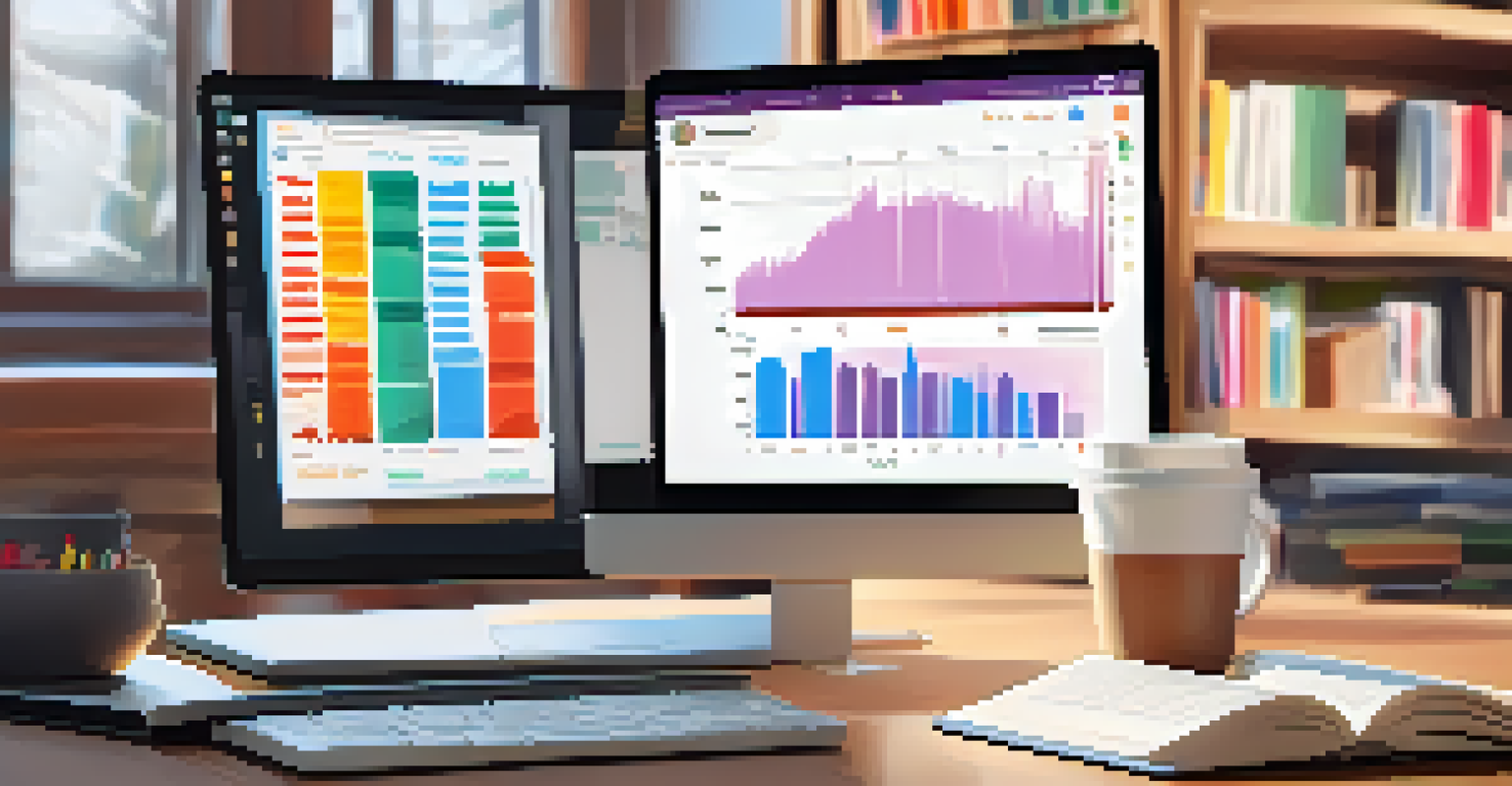Learning Analytics in Hybrid Learning Environments

Understanding Hybrid Learning Environments
Hybrid learning environments blend traditional face-to-face instruction with online elements, creating a dynamic educational experience. This approach allows for flexibility, catering to different learning styles and paces. Imagine a classroom where students can engage in discussions in person while also participating in online forums; this is the essence of hybrid learning.
Data is the new oil. It's valuable, but if unrefined it cannot really be used.
In these settings, educators can reach more students by leveraging technology, making education more accessible. However, the challenge lies in ensuring that all students receive equal attention and support, regardless of their learning context. This is where learning analytics can play a vital role, helping educators track student engagement and performance across both platforms.
By utilizing data from both in-person and online interactions, educators can gain insights into student behaviors and learning outcomes. This holistic view enables them to identify areas where students may struggle and adjust their teaching strategies accordingly. Ultimately, hybrid learning, when supported by analytics, fosters a more personalized learning journey.
The Role of Learning Analytics in Education
Learning analytics involves the collection, analysis, and interpretation of data related to learners and their contexts. It provides educators with valuable insights into student performance, helping them make informed decisions. Think of it as a GPS for teaching: it tells you where your students are and how to guide them to their destination.

In hybrid learning, the data collected from various platforms—such as online quizzes, discussion boards, and attendance logs—can be analyzed to understand patterns in student engagement. This allows educators to pinpoint when students are struggling or losing interest, enabling timely interventions. For example, if analytics reveal that students are not participating in online discussions, instructors can adjust their approach to encourage more interaction.
Hybrid Learning Offers Flexibility
Hybrid learning environments combine in-person and online instruction, catering to diverse learning styles and paces.
Moreover, learning analytics can enhance the overall learning experience by providing feedback to students themselves. When students receive insights into their learning habits and progress, they can take ownership of their education. This empowerment can lead to increased motivation and better academic outcomes, creating a win-win situation for both educators and learners.
Key Benefits of Learning Analytics in Hybrid Learning
One of the primary benefits of learning analytics is its ability to identify at-risk students early on. By analyzing data on attendance, participation, and assessment scores, educators can intervene before students fall too far behind. This proactive approach can significantly enhance student retention and success rates, making sure that no learner is left behind.
You can't manage what you don't measure.
Additionally, learning analytics can help personalize the educational experience. By understanding individual learning patterns and preferences, educators can tailor their teaching methods to better suit each student’s needs. Imagine a teacher who knows which students thrive on visual aids versus those who prefer hands-on activities; they can create a hybrid environment that caters to diverse learning styles.
Lastly, learning analytics fosters a culture of continuous improvement. By regularly analyzing data outcomes, educators can refine their curricula and teaching strategies based on what works best. This creates a dynamic learning environment that is always evolving, ultimately benefiting the entire educational community.
Challenges of Implementing Learning Analytics
Despite its benefits, implementing learning analytics in hybrid environments does come with challenges. One significant hurdle is data privacy; educators must ensure that student information is collected and stored securely. Striking a balance between utilizing data for improvement and protecting student privacy is crucial in maintaining trust.
Another challenge is the integration of various data sources. With students engaging in multiple platforms, consolidating this data for analysis can be daunting. Educators may find themselves sifting through mountains of information, which can lead to analysis paralysis if not managed effectively.
Learning Analytics Enhance Education
Utilizing learning analytics enables educators to track student engagement and performance, allowing for tailored interventions.
Lastly, there is often a lack of training in data interpretation among educators. While the technology may be available, without proper training, educators might struggle to make sense of the data provided. Investing in professional development is essential to empower teachers to leverage learning analytics effectively.
Best Practices for Using Learning Analytics
To maximize the benefits of learning analytics, educators should start by establishing clear objectives. Knowing what they want to achieve with the data will guide their approach and ensure they focus on the most relevant metrics. Setting specific, measurable goals can help streamline the analysis process and keep everyone on track.
Another best practice is to create a collaborative environment where educators can share insights and strategies. By fostering a culture of teamwork, educators can learn from each other’s experiences and develop more effective teaching methods. For instance, a group of teachers could come together to discuss trends they’ve observed in their respective classes, leading to innovative solutions.
Lastly, educators should prioritize transparency with students regarding how their data is used. When students understand that analytics aim to enhance their learning experience, they are more likely to engage positively with the process. Open communication builds trust and encourages students to take an active role in their education.
Future Trends in Learning Analytics
As technology continues to evolve, so too will learning analytics. One emerging trend is the integration of artificial intelligence (AI) to provide even deeper insights into student behavior. Imagine a system that can predict learning outcomes based on real-time data; this could revolutionize the way educators approach teaching in hybrid environments.
Additionally, there is a growing focus on predictive analytics, which aims to forecast student performance based on historical data. By identifying trends and patterns, educators can proactively address potential issues before they arise. This forward-thinking approach can lead to more effective interventions and support systems for students.
Data Privacy Is a Key Concern
While implementing learning analytics, educators must balance the benefits of data use with the need for student privacy and security.
Finally, the emphasis on learner-centered analytics is becoming more prominent. This means focusing not just on institutional metrics but also on the individual experiences of students. By prioritizing student perspectives, educators can create more engaging and effective hybrid learning environments that truly resonate with their learners.
Conclusion: Embracing Learning Analytics for Better Outcomes
In summary, learning analytics presents a powerful opportunity for enhancing hybrid learning environments. By providing insights into student performance and engagement, educators can tailor their approaches to meet individual needs. This not only supports student success but also fosters a more inclusive and effective learning atmosphere.
While challenges exist—such as data privacy and integration—embracing best practices can lead to significant improvements. As educators collaborate and share insights, they can create a community that thrives on continuous learning and adaptation. The future of education is bright when data-driven decisions are at the forefront.

Ultimately, the goal of learning analytics in hybrid environments is to empower both educators and students. By leveraging data to inform teaching and learning practices, we can create a more responsive education system that prepares students for success in an ever-changing world.